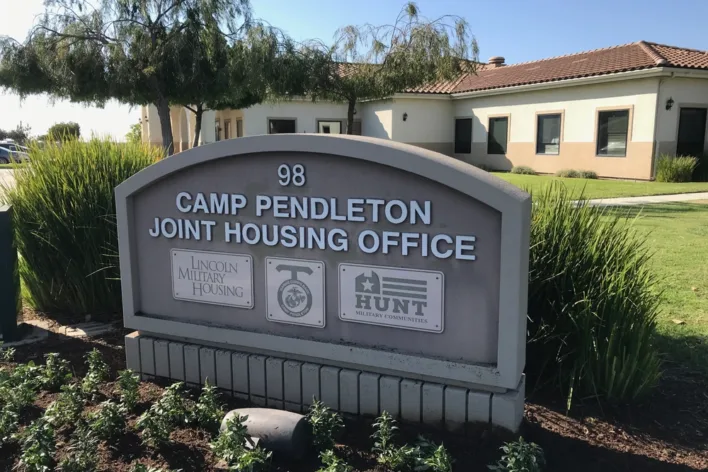DoD Announces Strategy to Fix Military Housing

In recent years, there have been many headlines rightfully complaining about the living and working conditions on military bases.
Black mold in the barracks, contaminated drinking water, and a lack of response to tenant complaints are only some of the many complaints about military bases and base housing.
Military Housing Fix Strategy Announced by the Department of Defense
To address these issues, the Department of Defense has announced a housing strategy meant to “ improve the built and natural environment on defense installations.”
The DoD Resilient and Healthy Defense Communities (RHDC) Strategy is a multi-year plan focusing on improving the quality of life for the two million military members and civilians who live and work at DoD facilities. The plan is much broader in scope than the military housing issue, but housing is a major concern.
The Resilient and Healthy Defense Communities (RHDC) Strategy
There are more than a quarter of a million buildings on more than 530 military bases, all covering over 25 million acres. For a long portion of military history, the Defense Department has acquired land and molded that land in service of the DoD. Now, that approach is changing, according to a government press release.
“These built and natural spaces are central” to the experiences of those who serve, “affecting their physical and mental health, ability to carry out their missions, and the overall recruitment and retention of the force.”
The Deputy Secretary of Defense, Kathleen Hicks, goes a step further. “It is both a national security imperative and our moral obligation to ensure the spaces where our people live, work, and train are healthy, functional, and resilient,”
According to Hicks, the new DoD approach focuses on people first. The DoD press release notes that the “military and civilian workforce rightfully expects a place to live and work that enhances their quality of life…”
Related: Tips for Buying Life Insurance
RHDC Strategy
The Defense Department admits its infrastructure needs help. Nearly 80% of all DoD installations “were established before 1970 and nearly 33 percent of built assets are more than 50 years old” according to the federal government.
And that’s not all. “Additionally, the number of incidents where hurricanes, flooding, and wildfire have left billion-plus dollar recovery actions in their wake”.
Human-Centered Standards
The text of the RHDC includes a lot of attention on the needs of the end user. For military families this translates directly into housing and base quality of life issues.
According to the document, “To maximize the benefit of our investments, we will implement the installation attributes that our users value most. Our infrastructure design and maintenance requirements will emphasize people and their safety, needs, preferences, and experiences to create spaces that support and protect them.”
The next paragraph in the RHDC on this topic is telling.
“We will invest in technologies to empower users with information and feedback mechanisms about their environment and to allow installation managers to monitor and deliver high-quality assets. We will promote strategies, design, and products that, where possible, avoid the use of harmful chemicals and toxins.”
And furthermore, “We will do so through consistent policy and reliable feedback loops that allow us to recognize and address problems that arise. Our installation design will take into account where our people live and work to make sure they have access to resources, such as food, recreation, and schools…”
And also, “…to ensure that we minimize potential exposure from mission driven hazards, such as emissions from tanks and planes.”
Those all seem to be direct nods to recent housing scandals where basic livability and safety of on-base living spaces are concerned.
What’s Next?
In general, there are three efforts to improve military facilities worldwide according to Defense.gov:
- Adopting human-centered requirements to create environments that do not just meet utilitarian needs and compliance standards, but promote purpose, productivity, and camaraderie.
- Optimizing the Department’s footprint to ensure the scale and scope of its infrastructure is aligned with the needs of DoD’s people and their mission.
- Transforming how the Department manages its portfolio by adopting a sustainment management strategy to help target investments that have the greatest impact on the condition of DoD facilities.
“This strategy represents an important step forward for the Department and our people, but it is a starting point rather than a finish line,” according to Assistant Secretary of Defense for Energy, Installations, and Environment Brendan Owens. It’s meant to serve as a long-term guide to how the department approaches existing and future facility management and upkeep.
Related: Tips for Buying Life Insurance
About the author
Editor-in-Chief Joe Wallace is a 13-year veteran of the United States Air Force and a former reporter/editor for Air Force Television News and the Pentagon Channel. His freelance work includes contract work for Motorola, VALoans.com, and Credit Karma. He is co-founder of Dim Art House in Springfield, Illinois, and spends his non-writing time as an abstract painter, independent publisher, and occasional filmmaker.


